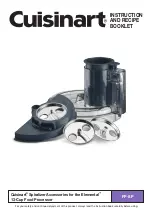
7
PREVENTIVE MAINTENANCE
Regular inspection and maintenance of air disc brake
components is an important part of vehicle maintenance.
The maintenance practices outlined here are recommended
in addition to all standard industry practices (including e.g.
daily pre-trip inspections, etc.) Also, see the vehicle's
manual for recommendations.
Use the table below for a guide to maintenance interval
planning,
however, depending on the vehicle use, more
frequent checks of the components may be necessary.
Keep track of the results of your maintenance inspec-
tions to assist you determine the ideal maintenance
interval for the vehicle.
Higher Duty Use
Over the Road
e.g. Pick-Up & Delivery,
Off-Highway, Construction,
Loggers, Concrete Mixer,
Dump Truck,
City Transit Bus, Refuse,
Urban Region Coach,
School Bus.
e.g. Line haul, RV,
Open Highway Coach.
Vehicle Used for:
•
For vehicles with electronic wear indicators,
use the dash indicator(s) and/or the hand-held
diagnostic tool to regularly monitor the pad
wear.
• In all cases,
visually inspect the wear indicator
(see Pages 8-9)
every four months
(or keep
track of the results of maintenance inspections
to schedule checks 4 to 5 times during the
pad lifetime).
At the same time, conduct the
Running Clearance Inspection
(see below).
• A visual check of the mechanical wear indicator
every time the tire pressures are checked is
recommended. Be alert for any rotor cracks,
etc. visible (See Page 13 for criteria.)
Pad & Rotor Wear,
Running Clearance
(Inspection with the wheel mounted)
Basic Inspection Program
At Least Once Annually and at
Every Pad Replacement
(Inspection with wheel removed)
Inspect:
•
The rotor for cracks, etc. (see
Page 13 for criteria)
• The running clearance
and adjuster function (see
Page 15)
• The caliper travel (see Pages
16-17)
• The tappet and boot
assemblies (see Page 14)
• All covers, caps, hoses, and
brake exterior for damage etc.
Air Disc Brake Running Clearance Inspection.
Follow all industry safety guidelines, including those listed on Page 2. On
level ground, with the wheels chocked and the parking brake temporarily
released, check for movement of the brake caliper. This small movement,
less than 0.80" (2 mm) - approximately the thickness of a nickel - in the
inboard/outboard direction indicates that the brake is moving properly
on its guide pins. If the caliper has no movement or appears to move
greater than the distances above, a full wheel-removed inspection will be
necessary. See Page 16.
•
For vehicles with electronic wear indicators,
use the dash indicator(s) and/or the hand-held
diagnostic tool to regularly monitor the pad
wear.
• In all cases,
visually inspect the wear indicator
(see Pages 8-9)
every three months
(or keep
track of the results of maintenance inspections
to schedule checks 4 to 5 times during the
pad lifetime).
At the same time, conduct the
Running Clearance Inspection
(see below).
• A visual check of the mechanical wear indicator
every time the tire pressures are checked is
recommended. Be alert for any rotor cracks,
etc. visible (See Page 13 for criteria.)








































